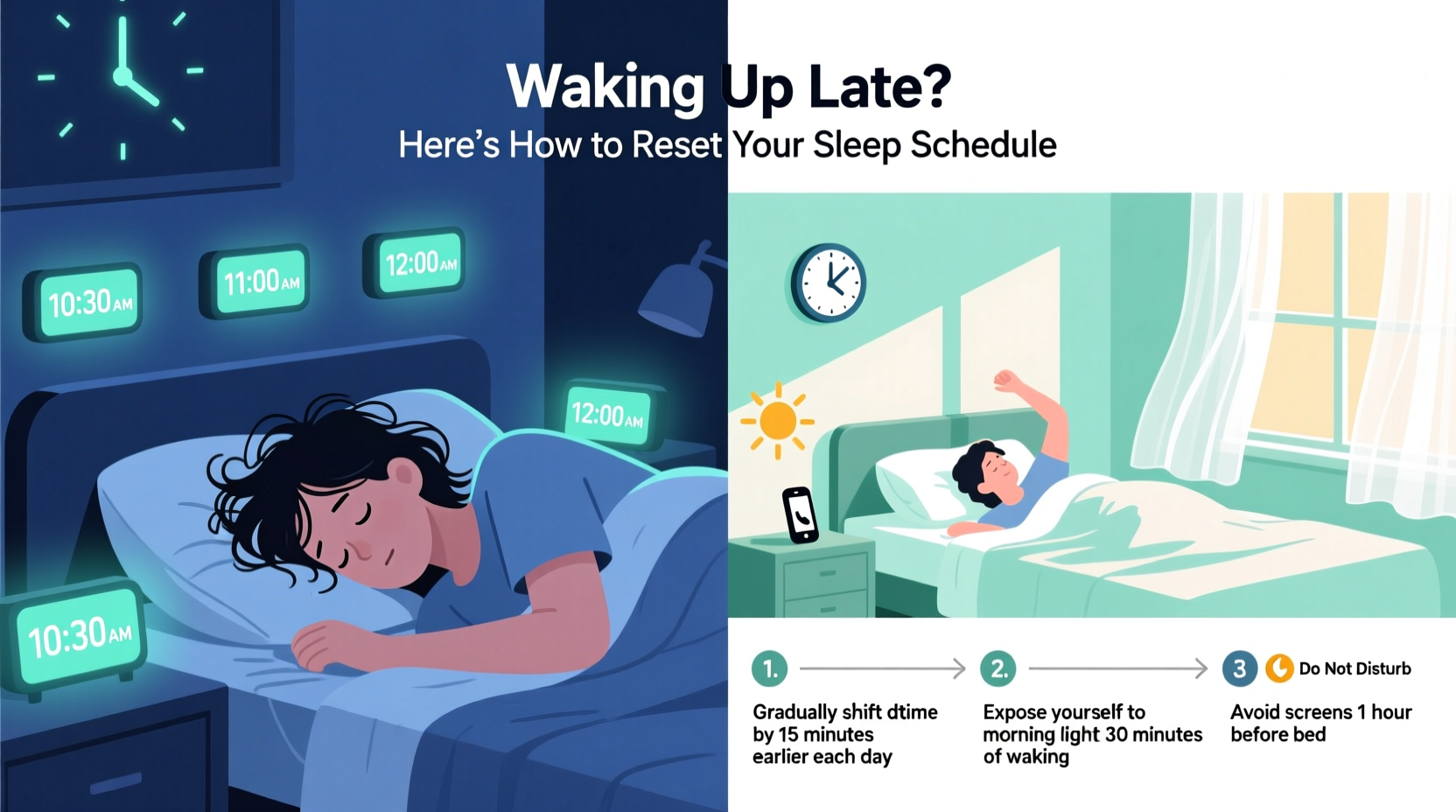Waking up late has become a common habit in modern life, often dismissed as a minor inconvenience. However, consistently rising past your ideal time can disrupt your circadian rhythm, impair cognitive function, reduce productivity, and increase the risk of long-term health issues such as obesity, depression, and cardiovascular disease. The good news is that your sleep schedule is not fixed. With intentional adjustments and consistent habits, you can reset your internal clock and reclaim mornings with energy and clarity.
The Hidden Impact of Waking Up Late

When you wake up late, especially if it's inconsistent or significantly later than your body expects, it throws off your biological clock. This internal system regulates everything from hormone release to body temperature and digestion. A misaligned circadian rhythm can lead to:
- Daytime fatigue and brain fog
- Mood swings and irritability
- Reduced concentration and memory retention
- Increase in stress hormones like cortisol
- Poorer metabolic function and appetite regulation
Chronic disruption may also contribute to insomnia or delayed sleep phase disorder (DSPD), where falling asleep and waking up naturally happens much later than societal norms allow. This creates a cycle: you stay up late because you can’t fall asleep early, then struggle to rise on time, leading to more fatigue and further delay the next night.
How to Reset Your Sleep Schedule: A Step-by-Step Guide
Resetting your sleep schedule doesn’t require drastic changes overnight. Instead, use gradual, sustainable shifts to retrain your body’s natural rhythm. Follow this seven-day timeline to make meaningful progress:
- Day 1–2: Assess & Anchor
Determine your current average wake-up time. Set a realistic target wake-up time—no more than 30–60 minutes earlier than usual. Commit to this time daily, even on weekends. - Day 3–4: Adjust Bedtime Gradually
Go to bed 15 minutes earlier each night. Pair this with a wind-down routine: dim lights, avoid screens, and engage in calming activities like reading or light stretching. - Day 5–6: Optimize Morning Light Exposure
Spend at least 10–15 minutes outside within 30 minutes of waking. Natural sunlight suppresses melatonin and signals your brain that the day has begun. - Day 7: Evaluate & Refine
Track how you feel upon waking and throughout the day. If you’re still tired, shift bedtime another 15 minutes earlier the following week.
This incremental approach prevents shock to your system and increases adherence. Research shows that small, consistent changes are more effective than abrupt overhauls.
Do’s and Don’ts When Resetting Your Sleep Cycle
| Do’s | Don’ts |
|---|---|
| Wake up at the same time every day | Hit snooze repeatedly |
| Get morning sunlight exposure | Use bright screens right after waking |
| Establish a pre-sleep routine | Consume caffeine after 2 PM |
| Exercise regularly (but not too close to bedtime) | Take long naps late in the day |
| Create a cool, dark sleeping environment | Use your bed for work or screen time |
Real-Life Example: Sarah’s Transformation
Sarah, a 29-year-old graphic designer, routinely woke up at 10:30 AM despite wanting to start her day earlier. She felt sluggish until noon and struggled to focus on client projects. After consulting a sleep coach, she committed to a two-week reset plan. She began by setting her alarm for 9:30 AM—30 minutes earlier than usual—and placed her coffee maker on a timer so the smell would help rouse her. Each morning, she walked her dog around the block to get sunlight. Over ten days, she moved her wake-up time back to 7:30 AM. Within three weeks, she reported improved mood, sharper focus, and even began exercising before work. Her productivity increased, and she no longer relied on afternoon energy drinks.
“Consistency is more powerful than perfection when resetting your sleep. One missed morning won’t ruin progress—but giving up will.” — Dr. Lena Torres, Clinical Sleep Specialist
Actionable Tips to Support Your Reset
Sleep Reset Checklist
- ✅ Set a fixed wake-up time (same every day)
- ✅ Expose yourself to natural light within 30 minutes of waking
- ✅ Avoid caffeine after 2 PM
- ✅ Establish a 30–60 minute wind-down routine before bed
- ✅ Keep your bedroom cool, dark, and quiet
- ✅ Limit screen time one hour before sleep
- ✅ Use your bed only for sleep and intimacy
- ✅ Track your sleep and wake times for at least one week
Frequently Asked Questions
How long does it take to reset your sleep schedule?
Most people begin to notice improvements within 3–5 days, but full adjustment typically takes 1–2 weeks. Factors like age, lifestyle, and existing sleep disorders can influence the timeline. Patience and consistency are key.
Can I reset my sleep schedule without changing my bedtime?
Yes—starting with wake time is often more effective. Waking up at the same time daily, regardless of when you fell asleep, helps anchor your circadian rhythm. Once wake time is stable, bedtime will naturally shift earlier over time.
What if I’m still tired after waking up early?
Initial fatigue is normal. Ensure you’re getting enough total sleep (7–9 hours). If you're waking earlier but not adjusting bedtime soon after, you may be sleep-deprived. Gradually move bedtime earlier while maintaining your new wake-up time.
Conclusion: Reclaim Your Mornings, Reclaim Your Day
Waking up late isn’t just about lost morning hours—it’s a signal of deeper imbalance in your body’s natural rhythm. By taking deliberate, science-backed steps to reset your sleep schedule, you restore energy, improve mental clarity, and build resilience against stress and burnout. The process doesn’t demand perfection, only persistence. Begin today by setting a fixed wake-up time and stepping into the sunlight. Small choices compound into lasting change. Your most productive, peaceful self starts with a single morning well begun.









 浙公网安备
33010002000092号
浙公网安备
33010002000092号 浙B2-20120091-4
浙B2-20120091-4
Comments
No comments yet. Why don't you start the discussion?